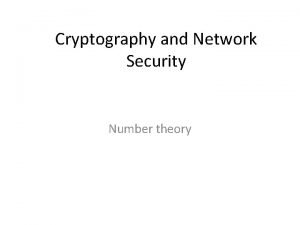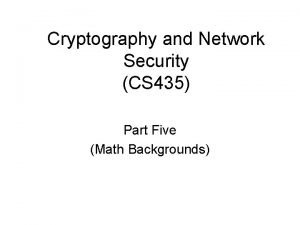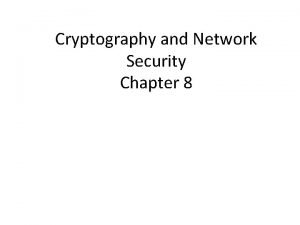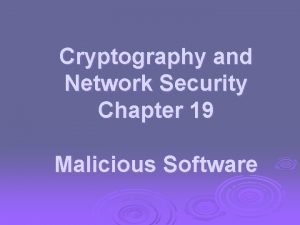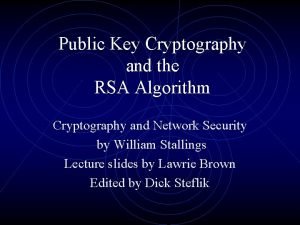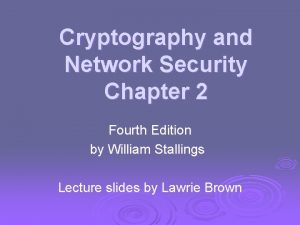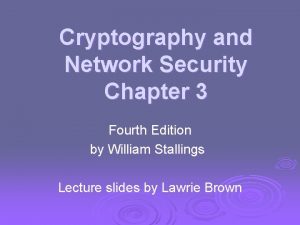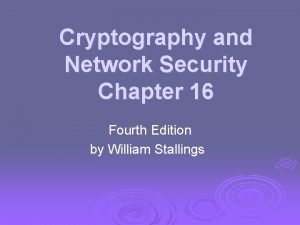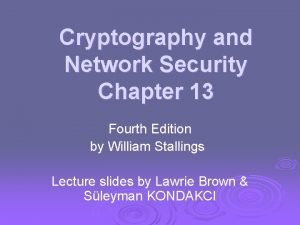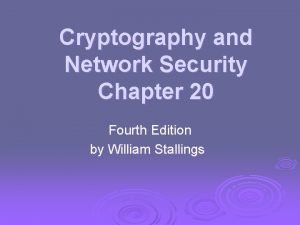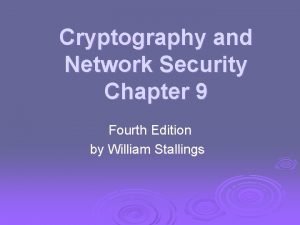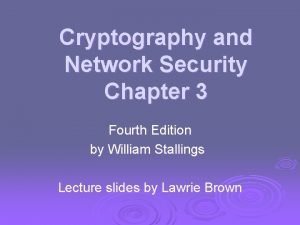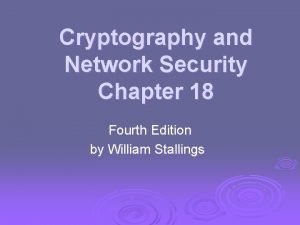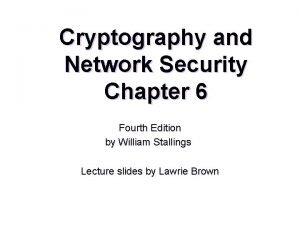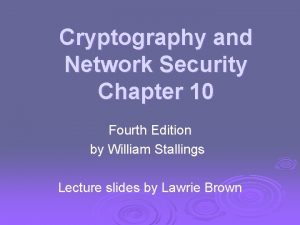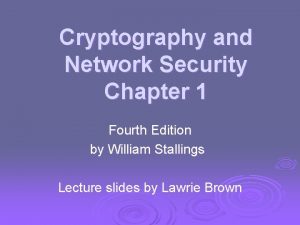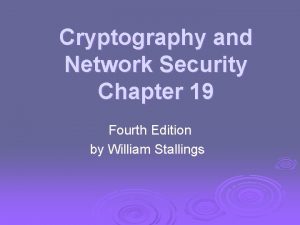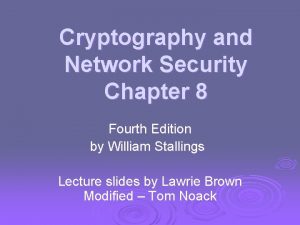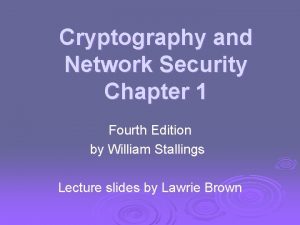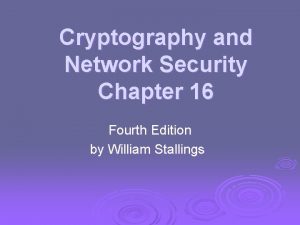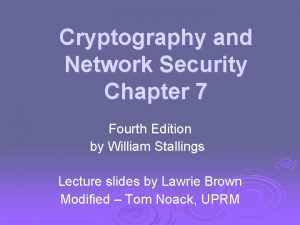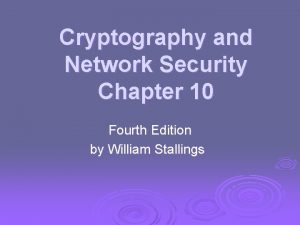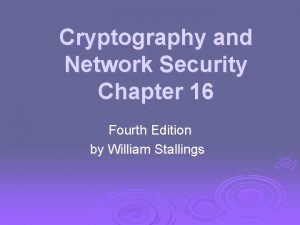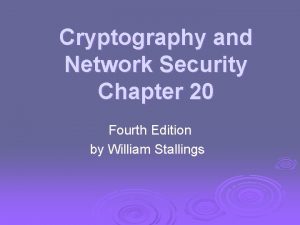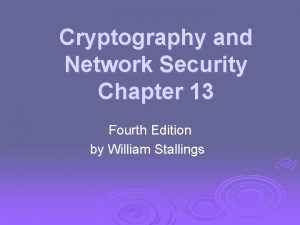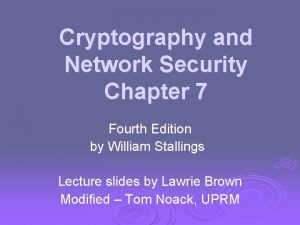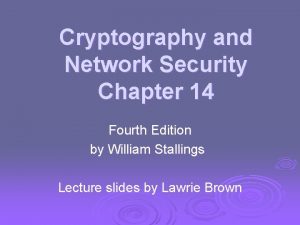Cryptography and Network Security Chapter 9 Fourth Edition























- Slides: 23

Cryptography and Network Security Chapter 9 Fourth Edition by William Stallings Lecture slides by Lawrie Brown

Chapter 9 – Public Key Cryptography and RSA Every Egyptian received two names, which were known respectively as the true name and the good name, or the great name and the little name; and while the good or little name was made public, the true or great name appears to have been carefully concealed. —The Golden Bough, Sir James George Frazer

Private-Key Cryptography Ø traditional private/secret/single key cryptography uses one key Ø shared by both sender and receiver Ø if this key is disclosed communications are compromised Ø also is symmetric, parties are equal Ø hence does not protect sender from receiver forging a message & claiming is sent by sender

Public-Key Cryptography Ø probably most significant advance in the 3000 year history of cryptography Ø uses two keys – a public & a private key Ø asymmetric since parties are not equal Ø uses clever application of number theoretic concepts to function Ø complements rather than replaces private key crypto

Why Public-Key Cryptography? Ø developed to address two key issues: l l key distribution – how to have secure communications in general without having to trust a KDC with your key digital signatures – how to verify a message comes intact from the claimed sender Ø public invention due to Whitfield Diffie & Martin Hellman at Stanford Uni in 1976 l known earlier in classified community

Public-Key Cryptography Ø public-key/two-key/asymmetric cryptography involves the use of two keys: l l Ø a public-key, which may be known by anybody, and can be used to encrypt messages, and verify signatures a private-key, known only to the recipient, used to decrypt messages, and sign (create) signatures is asymmetric because l those who encrypt messages or verify signatures cannot decrypt messages or create signatures

Public-Key Cryptography

Public-Key Characteristics Ø Public-Key algorithms rely on two keys where: l l l it is computationally infeasible to find decryption key knowing only algorithm & encryption key it is computationally easy to en/decrypt messages when the relevant (en/decrypt) key is known either of the two related keys can be used for encryption, with the other used for decryption (for some algorithms)

Public-Key Cryptosystems

Public-Key Applications Ø can classify uses into 3 categories: l l l encryption/decryption (provide secrecy) digital signatures (provide authentication) key exchange (of session keys) Ø some algorithms are suitable for all uses, others are specific to one

Security of Public Key Schemes like private key schemes brute force exhaustive search attack is always theoretically possible Ø but keys used are too large (>512 bits) Ø security relies on a large enough difference in difficulty between easy (en/decrypt) and hard (cryptanalyse) problems Ø more generally the hard problem is known, but is made hard enough to be impractical to break Ø requires the use of very large numbers Ø hence is slow compared to private key schemes Ø

RSA by Rivest, Shamir & Adleman of MIT in 1977 Ø best known & widely used public-key scheme Ø based on exponentiation in a finite (Galois) field over integers modulo a prime Ø l nb. exponentiation takes O((log n)3) operations (easy) uses large integers (eg. 1024 bits) Ø security due to cost of factoring large numbers Ø l nb. factorization takes O(e log n) operations (hard)

RSA Key Setup each user generates a public/private key pair by: selecting two large primes at random - p, q Ø computing their system modulus n=p. q Ø Ø l Ø note ø(n)=(p-1)(q-1) selecting at random the encryption key e • where 1<e<ø(n), gcd(e, ø(n))=1 Ø solve following equation to find decryption key d l e. d=1 mod ø(n) and 0≤d≤n publish their public encryption key: PU={e, n} Ø keep secret private decryption key: PR={d, n} Ø

RSA Use Ø to encrypt a message M the sender: l l obtains public key of recipient PU={e, n} computes: C = Me mod n, where 0≤M<n Ø to decrypt the ciphertext C the owner: l l uses their private key PR={d, n} computes: M = Cd mod n Ø note that the message M must be smaller than the modulus n (block if needed)

Why RSA Works Ø because of Euler's Theorem: l Ø in RSA have: l l Ø aø(n)mod n = 1 where gcd(a, n)=1 n=p. q ø(n)=(p-1)(q-1) carefully chose e & d to be inverses mod ø(n) hence e. d=1+k. ø(n) for some k hence : Cd = Me. d = M 1+k. ø(n) = M 1. (Mø(n))k = M 1. (1)k = M 1 = M mod n

RSA Example - Key Setup 1. 2. 3. 4. 5. 6. 7. Select primes: p=17 & q=11 Compute n = pq =17 x 11=187 Compute ø(n)=(p– 1)(q-1)=16 x 10=160 Select e: gcd(e, 160)=1; choose e=7 Determine d: de=1 mod 160 and d < 160 Value is d=23 since 23 x 7=161= 10 x 160+1 Publish public key PU={7, 187} Keep secret private key PR={23, 187}

RSA Example - En/Decryption Ø sample RSA encryption/decryption is: Ø given message M = 88 (nb. 88<187) Ø encryption: C = 887 mod 187 = 11 Ø decryption: M = 1123 mod 187 = 88

RSA Key Generation Ø users of RSA must: l l determine two primes at random - p, q select either e or d and compute the other Ø primes p, q must not be easily derived from modulus n=p. q l l means must be sufficiently large typically guess and use probabilistic test Ø exponents e, d are inverses, so use Inverse algorithm to compute the other

RSA Security Ø possible approaches to attacking RSA are: l l brute force key search (infeasible given size of numbers) mathematical attacks (based on difficulty of computing ø(n), by factoring modulus n) timing attacks (on running of decryption) chosen ciphertext attacks (given properties of RSA)

Factoring Problem Ø mathematical approach takes 3 forms: l l l Ø factor n=p. q, hence compute ø(n) and then d determine ø(n) directly and compute d find d directly currently believe all equivalent to factoring l currently assume 1024 -2048 bit RSA is secure • ensure p, q of similar size and matching other constraints

Timing Attacks developed by Paul Kocher in mid-1990’s Ø exploit timing variations in operations Ø l eg. multiplying by small vs large number infer operand size based on time taken Ø RSA exploits time taken in exponentiation Ø

Chosen Ciphertext Attacks • • • RSA is vulnerable to a Chosen Ciphertext Attack (CCA) attackers chooses ciphertexts & gets decrypted plaintext back choose ciphertext to exploit properties of RSA to provide info to help cryptanalysis can counter with random pad of plaintext or use Optimal Asymmetric Encryption Padding (OASP)

Summary Ø have considered: l l principles of public-key cryptography RSA algorithm, implementation, security
 Cryptography and network security 6th edition
Cryptography and network security 6th edition Cryptography and network security 6th edition pdf
Cryptography and network security 6th edition pdf Cryptography and network security 4th edition
Cryptography and network security 4th edition Pearson cryptography and network security
Pearson cryptography and network security Wireless security in cryptography and network security
Wireless security in cryptography and network security криптографический модуль
криптографический модуль Number theory in cryptography and network security
Number theory in cryptography and network security Firewall base layer
Firewall base layer Authentication in cryptography and network security
Authentication in cryptography and network security Intruders in network security
Intruders in network security Primitive root in cryptography
Primitive root in cryptography Euler's theorem in cryptography and network security
Euler's theorem in cryptography and network security Euler's theorem in cryptography and network security
Euler's theorem in cryptography and network security Finite fields in cryptography and network security
Finite fields in cryptography and network security Dsa in network security
Dsa in network security Gcd(1970,1066)
Gcd(1970,1066) Pgp in cryptography and network security
Pgp in cryptography and network security Euler's theorem in cryptography and network security
Euler's theorem in cryptography and network security Malicious software in cryptography
Malicious software in cryptography Introduction to cryptography and network security
Introduction to cryptography and network security Rsa algorithm in cryptography and network security
Rsa algorithm in cryptography and network security Introduction to cryptography and network security
Introduction to cryptography and network security Expert systems: principles and programming, fourth edition
Expert systems: principles and programming, fourth edition Network security essentials 5th edition pdf
Network security essentials 5th edition pdf












